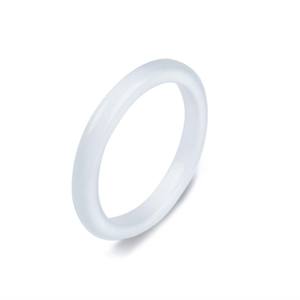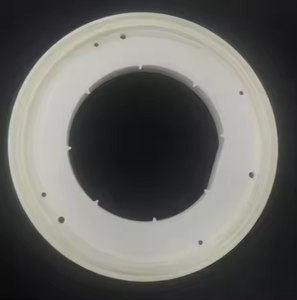1. Material Principles and Microstructural Features of Alumina Ceramics
1.1 Make-up, Pureness Qualities, and Crystallographic Residence
(Alumina Ceramic Wear Liners)
Alumina (Al Two O FIVE), or light weight aluminum oxide, is just one of the most extensively made use of technological ceramics in industrial design because of its excellent balance of mechanical stamina, chemical stability, and cost-effectiveness.
When crafted right into wear linings, alumina porcelains are normally fabricated with purity levels ranging from 85% to 99.9%, with higher pureness representing boosted firmness, use resistance, and thermal performance.
The leading crystalline phase is alpha-alumina, which embraces a hexagonal close-packed (HCP) structure identified by strong ionic and covalent bonding, contributing to its high melting factor (~ 2072 ° C )and low thermal conductivity.
Microstructurally, alumina ceramics include penalty, equiaxed grains whose size and circulation are controlled throughout sintering to enhance mechanical residential properties.
Grain dimensions typically vary from submicron to several micrometers, with finer grains usually improving crack durability and resistance to crack propagation under rough filling.
Small additives such as magnesium oxide (MgO) are usually presented in trace amounts to prevent abnormal grain development during high-temperature sintering, making certain uniform microstructure and dimensional stability.
The resulting product displays a Vickers solidity of 1500– 2000 HV, considerably going beyond that of hardened steel (typically 600– 800 HV), making it exceptionally resistant to surface area deterioration in high-wear settings.
1.2 Mechanical and Thermal Performance in Industrial Issues
Alumina ceramic wear liners are picked mainly for their outstanding resistance to rough, abrasive, and sliding wear devices prevalent wholesale material dealing with systems.
They have high compressive strength (up to 3000 MPa), excellent flexural stamina (300– 500 MPa), and superb stiffness (Young’s modulus of ~ 380 GPa), enabling them to stand up to extreme mechanical loading without plastic deformation.
Although naturally brittle compared to steels, their reduced coefficient of friction and high surface solidity reduce fragment adhesion and reduce wear prices by orders of magnitude relative to steel or polymer-based options.
Thermally, alumina keeps architectural integrity approximately 1600 ° C in oxidizing ambiences, permitting usage in high-temperature handling settings such as kiln feed systems, central heating boiler ducting, and pyroprocessing devices.
( Alumina Ceramic Wear Liners)
Its low thermal development coefficient (~ 8 × 10 ⁻⁶/ K) adds to dimensional stability during thermal biking, reducing the threat of cracking because of thermal shock when appropriately installed.
In addition, alumina is electrically protecting and chemically inert to most acids, antacid, and solvents, making it appropriate for harsh atmospheres where metal liners would certainly break down quickly.
These combined buildings make alumina porcelains excellent for shielding essential framework in mining, power generation, cement manufacturing, and chemical handling industries.
2. Production Processes and Layout Assimilation Approaches
2.1 Forming, Sintering, and Quality Control Protocols
The manufacturing of alumina ceramic wear linings involves a series of precision production steps created to accomplish high thickness, very little porosity, and regular mechanical efficiency.
Raw alumina powders are processed via milling, granulation, and developing strategies such as completely dry pressing, isostatic pressing, or extrusion, depending upon the wanted geometry– ceramic tiles, plates, pipes, or custom-shaped sections.
Environment-friendly bodies are after that sintered at temperature levels between 1500 ° C and 1700 ° C in air, advertising densification through solid-state diffusion and accomplishing loved one densities exceeding 95%, often coming close to 99% of theoretical density.
Full densification is vital, as residual porosity acts as anxiety concentrators and speeds up wear and crack under service conditions.
Post-sintering procedures may consist of diamond grinding or washing to accomplish tight dimensional tolerances and smooth surface area finishes that reduce friction and particle trapping.
Each set goes through rigorous quality assurance, including X-ray diffraction (XRD) for phase evaluation, scanning electron microscopy (SEM) for microstructural examination, and solidity and bend testing to verify compliance with worldwide requirements such as ISO 6474 or ASTM B407.
2.2 Mounting Strategies and System Compatibility Factors To Consider
Effective assimilation of alumina wear linings into industrial devices needs cautious interest to mechanical add-on and thermal development compatibility.
Typical installment methods consist of sticky bonding utilizing high-strength ceramic epoxies, mechanical securing with studs or supports, and embedding within castable refractory matrices.
Glue bonding is extensively made use of for level or gently bent surface areas, offering uniform anxiety distribution and vibration damping, while stud-mounted systems permit very easy replacement and are preferred in high-impact zones.
To suit differential thermal development in between alumina and metallic substratums (e.g., carbon steel), engineered gaps, versatile adhesives, or compliant underlayers are included to stop delamination or breaking throughout thermal transients.
Designers should also take into consideration side defense, as ceramic floor tiles are prone to breaking at exposed corners; remedies consist of diagonal sides, steel shrouds, or overlapping ceramic tile configurations.
Appropriate installation guarantees lengthy life span and takes full advantage of the protective function of the liner system.
3. Use Mechanisms and Performance Assessment in Service Environments
3.1 Resistance to Abrasive, Erosive, and Effect Loading
Alumina ceramic wear liners master settings controlled by three main wear systems: two-body abrasion, three-body abrasion, and bit erosion.
In two-body abrasion, tough fragments or surfaces directly gouge the liner surface area, an usual incident in chutes, receptacles, and conveyor shifts.
Three-body abrasion entails loosened bits trapped in between the liner and moving product, bring about rolling and scratching action that progressively eliminates product.
Abrasive wear takes place when high-velocity particles strike the surface, specifically in pneumatic sharing lines and cyclone separators.
Due to its high firmness and reduced fracture sturdiness, alumina is most effective in low-impact, high-abrasion scenarios.
It performs exceptionally well against siliceous ores, coal, fly ash, and concrete clinker, where wear rates can be decreased by 10– 50 times compared to mild steel liners.
Nonetheless, in applications entailing repeated high-energy impact, such as key crusher chambers, hybrid systems integrating alumina tiles with elastomeric supports or metallic guards are frequently used to absorb shock and prevent crack.
3.2 Field Screening, Life Process Analysis, and Failing Mode Analysis
Efficiency assessment of alumina wear liners includes both research laboratory screening and field monitoring.
Standardized examinations such as the ASTM G65 dry sand rubber wheel abrasion examination offer relative wear indices, while tailored slurry disintegration rigs replicate site-specific conditions.
In industrial settings, wear rate is commonly gauged in mm/year or g/kWh, with service life estimates based upon preliminary density and observed destruction.
Failure settings consist of surface area polishing, micro-cracking, spalling at sides, and total ceramic tile dislodgement as a result of glue degradation or mechanical overload.
Root cause analysis usually reveals setup mistakes, incorrect quality selection, or unexpected impact lots as primary factors to early failure.
Life cycle price evaluation continually demonstrates that regardless of greater preliminary prices, alumina liners offer exceptional complete cost of ownership due to extensive substitute periods, minimized downtime, and reduced maintenance labor.
4. Industrial Applications and Future Technological Advancements
4.1 Sector-Specific Executions Across Heavy Industries
Alumina ceramic wear linings are deployed across a broad spectrum of industrial markets where product deterioration positions operational and financial challenges.
In mining and mineral processing, they protect transfer chutes, mill linings, hydrocyclones, and slurry pumps from unpleasant slurries consisting of quartz, hematite, and other hard minerals.
In nuclear power plant, alumina ceramic tiles line coal pulverizer air ducts, central heating boiler ash hoppers, and electrostatic precipitator elements subjected to fly ash erosion.
Concrete makers utilize alumina liners in raw mills, kiln inlet zones, and clinker conveyors to fight the extremely rough nature of cementitious products.
The steel sector employs them in blast heater feed systems and ladle shrouds, where resistance to both abrasion and moderate thermal lots is important.
Also in less standard applications such as waste-to-energy plants and biomass handling systems, alumina ceramics offer sturdy protection versus chemically hostile and fibrous products.
4.2 Emerging Fads: Compound Solutions, Smart Liners, and Sustainability
Present research concentrates on boosting the durability and capability of alumina wear systems with composite design.
Alumina-zirconia (Al Two O FIVE-ZrO TWO) composites utilize improvement strengthening from zirconia to enhance crack resistance, while alumina-titanium carbide (Al ₂ O TWO-TiC) grades offer improved performance in high-temperature moving wear.
One more innovation includes embedding sensing units within or underneath ceramic linings to keep an eye on wear progression, temperature, and impact frequency– enabling predictive maintenance and digital twin integration.
From a sustainability perspective, the extensive life span of alumina liners minimizes material consumption and waste generation, lining up with round economic climate concepts in commercial operations.
Recycling of invested ceramic linings into refractory aggregates or building and construction materials is additionally being discovered to reduce ecological impact.
To conclude, alumina ceramic wear linings stand for a cornerstone of modern-day commercial wear protection innovation.
Their extraordinary firmness, thermal stability, and chemical inertness, integrated with fully grown production and setup methods, make them indispensable in combating material degradation throughout heavy industries.
As product science breakthroughs and digital monitoring becomes extra integrated, the future generation of smart, resistant alumina-based systems will certainly further enhance functional efficiency and sustainability in rough atmospheres.
Distributor
Alumina Technology Co., Ltd focus on the research and development, production and sales of aluminum oxide powder, aluminum oxide products, aluminum oxide crucible, etc., serving the electronics, ceramics, chemical and other industries. Since its establishment in 2005, the company has been committed to providing customers with the best products and services. If you are looking for high quality hydrated alumina, please feel free to contact us. (nanotrun@yahoo.com)
Tags: Alumina Ceramic Wear Liners, Alumina Ceramics, alumina
All articles and pictures are from the Internet. If there are any copyright issues, please contact us in time to delete.
Inquiry us

